Heidelberg is an attractive city situated in southwestern Germany, approximately one hour south of Frankfurt.
It is nestled in the Neckar river valley, surrounded by vineyards and woodlands. Despite its relatively small size of about 150,000 inhabitants, Heidelberg enjoys a culturally diverse and international atmosphere.
The city is located in Baden-Württemberg and is part of Germany's famous "Castle Road". Known for its historical charm, Heidelberg remained largely untouched during World War II.

A view over Heidelberg in southwestern Germany
The fascinating Old Town, known as the 'Altstadt' in German, is situated at the foot of the castle hill and has been recognised as a UNESCO World Heritage Site.
Heidelberg is home to a renowned university, the oldest in Germany, which gives the streets and squares of the centre a youthful and lively atmosphere.
Some of the reasons to make a visit to Heidelberg:
Frankfurt Airport (also known as Rhein-Main Airport) is the closest airport to Heidelberg. It is also the busiest airport in Germany, so the choice of airlines and destinations worldwide is going offer the best options.
Distance to Frankfurt Airport: 82km
Distance to Karlsruhe-Baden-Baden Airport: 88km
Distance to Stuttgart Airport: 103km
The other two airports are within easy reach of the city and are worth a look if Frankfurt arrival times or flight prices are not suitable.
The main Heidelberg train station ('Heidelberg Hauptbahnhof') is located around two kilometres to the west of the old town. There are regular public transport services via bus or tram to the city centre.
Heidelberg is completely connected into the high-speed German rail network, with regular services to cities such as Hamburg, Munich and, of course, Frankfurt.
It is also part of the extensive suburban Rhein-Neckar network, which links cities such as Mannheim, Ludswigsburg, Karlsruhe and Mainz via a frequent S-Bahn service.
There is plenty of accommodation either in the area near the train station or in and around the old town of Heidelberg.
If you know when you are planning to go but haven't decided on accommodation, then use the map below to get an idea of which properties are available and to compare prices during the period you wish to travel.
Enter your proposed dates and use the '+' to zoom in on a location and reveal more properties. Click on the price above a property to see more information.
(Please note that this selection will also include some guesthouses, pensions and self-catering apartments for those who are interested in that form of accommodation!)
Alternatively, if you would like a list of properties available on your proposed dates of travel, use the search box below to find accommodation:
Visitors to Heidelberg should consider the purchase of a Heidelberg Card. This is available for 1, 2 and 4 days and covers entry into various sights and attractions, such as the funicular railway, the castle and the university buildings. It also covers use of public transport (buses, trams and local trains) in the Heidelberg area.
The Heidelberg Card is available from the tourist information centres around the city.
One of the main attractions is Heidelberg Castle ('Schloss Heidelberg'), a romantic ruin towering over the city. Enjoy stunning views of the Old Town and the Neckar Valley below while exploring the castle grounds.
The castle also houses a variety of architecturally striking buildings from different historical periods. American author Mark Twain called it "one of the most charming sights in the world".
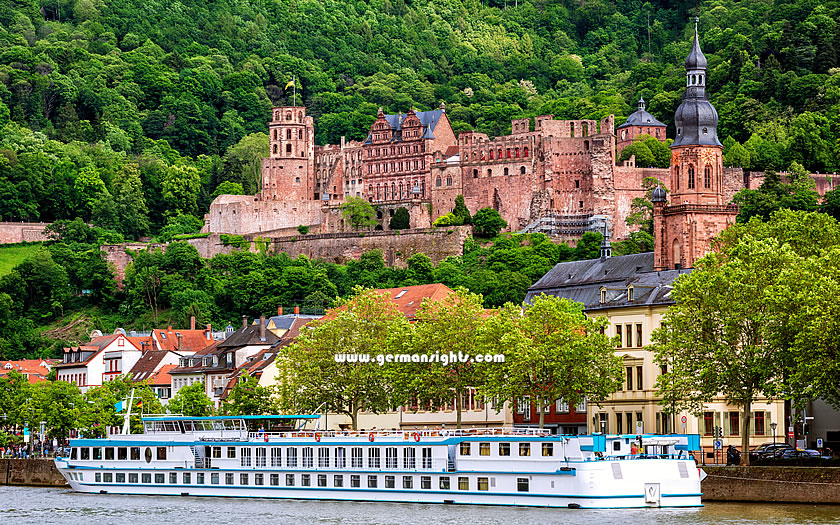
Heidelberg castle and a ferry on the river Neckar in Germany
Heidelberg Castle has a rich history that spans many centuries.
It was first mentioned in 1196 and became the main residence of the Counts Palatine. The castle itself was expanded and rebuilt multiple times, with major construction taking place in the 13th and 16th centuries.
The castle played a role in various historical events, such as being a coronation camp for King Ruprecht of Germany in 1401 and hosting Martin Luther during his visit to Heidelberg in 1518.
During the Thirty Years War, the castle was captured, destroyed, and rebuilt several times by different forces.
In 1689, the castle was set on fire by French troops during the Nine Years War, leading to its ruinous state.
Throughout the 18th and 19th centuries, the castle decayed further but gained attention from artists and tourists as a romantic ruin.
Restoration efforts began in the late 19th century, with some parts reconstructed while others were preserved or repaired based on expert recommendations.
Today, Heidelberg Castle is a symbol of the city’s history and attracts more than a million visitors each year.
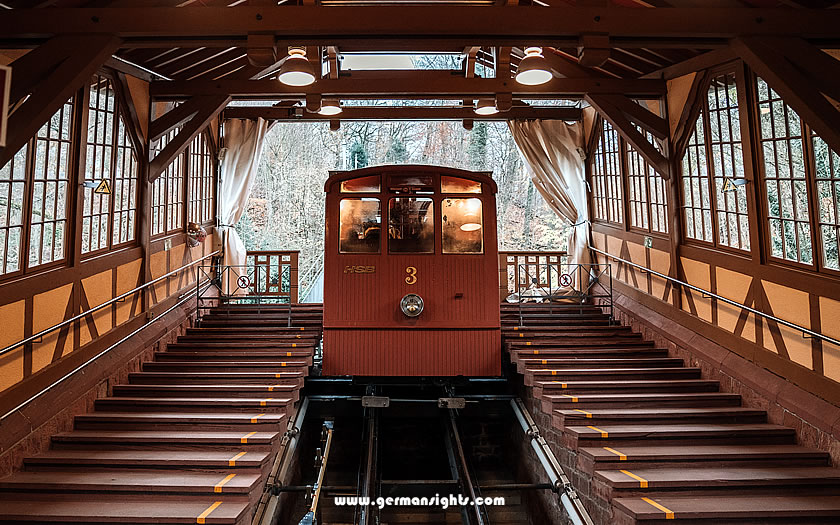
The funicular railway up to Heidelberg castle
Most visitors take the funicular railway ('Bergbahn') to the castle, although it is possible to walk up the Königstuhl hill. The funicular travels further to the Molkenkur and Königstuhl stops. There is an observatory and planetarium at the Königstuhl terminus.
The castle is open every day and tours in English (additional fee) are available every hour. Entrance also includes admission to the German Pharmacy Museum and to the Great Barrel ('Heidelberg Tun'), a barrel that once held 220,000 litres of wine.
Website: www.schloss-heidelberg.de
The old town ('Altstadt') is located between the castle hill and the left bank of the River Neckar. It is worth taking a few hours to wander around the historic centre of the city and soak up the atmosphere.
The city centre houses the buildings of the old university, which was founded originally back in the 14th century. Those who are interested in the history of the city can visit the Kurpfälzisches Museum ('Palatinate Museum'), with its displays of local culture, archaeology and art.
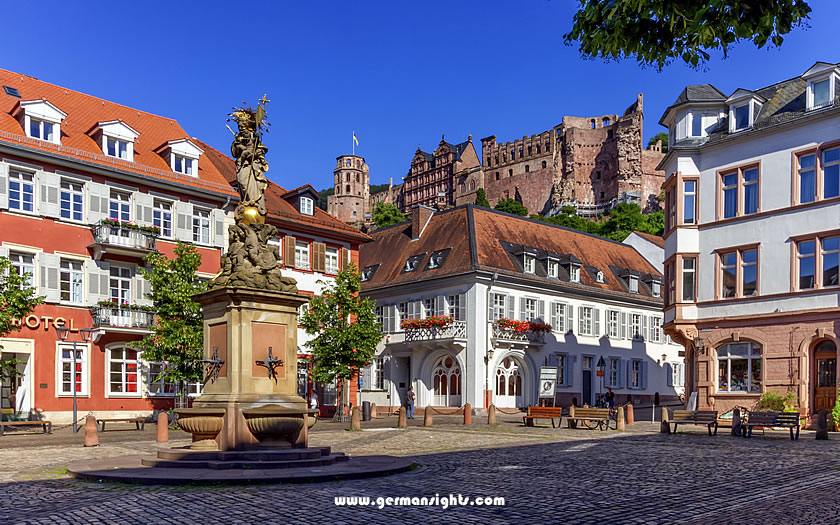
The Kornmarkt square in Heidelberg
There are several interesting squares in the city:
The Old Bridge ('Alte Brücke') spans the Neckar river and links the old town to the suburb of Neuenheim. It was built in the 18th century and offers superb views of both banks of the river.
Its proper name is actually the Karl-Theodor-Brücke, named after one of the rulers of Heidelberg. It is the ninth bridge to be built on this spot - the previous versions having been destroyed by high water and ice breaking up.
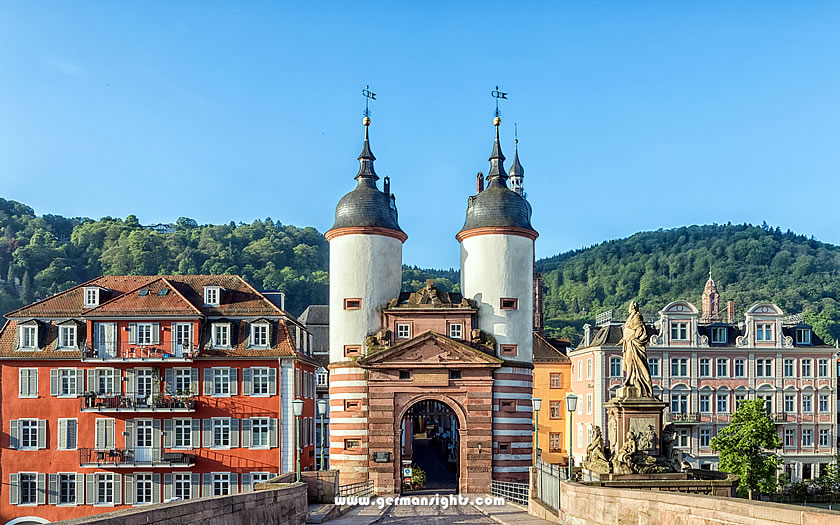
The Old Bridge and the Bridge Gate in Heidelberg
The Bridge Gate ('Brückentor') stands at the south end of the bridge and used to be part of the city fortifications.
The Philosophers' Walk ('Philosophenweg') starts on the opposite bank of the river. It can be reached by a switchback trail ('Schlangenweg') through vineyards from the end of the Old Bridge.
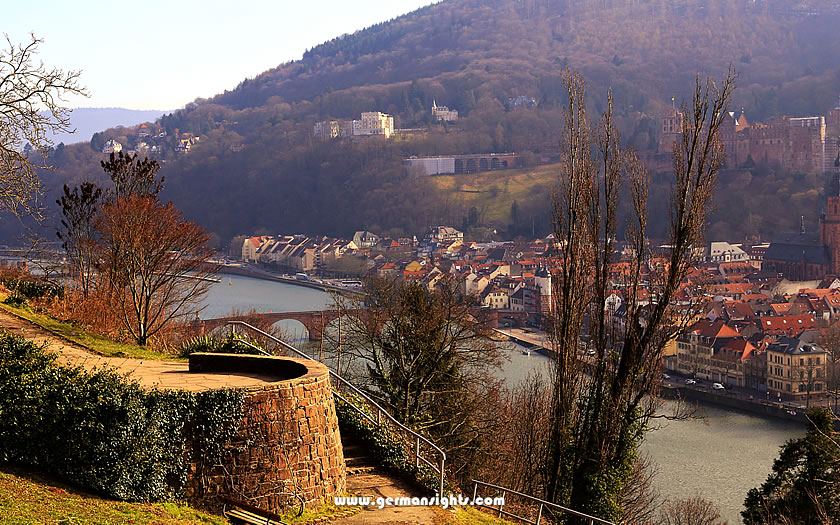
The Philosophers' Walk in Heidelberg
There are several lovely panoramas of the city and river from viewpoints along the trail such as the Meriankanzel and the Bismarcksäule.
The name of the walk is thought to come not from famous philosophers, but from students at the university who once had to study philosophy as a compulsory part of their courses.
Here is a quick video overview of a hiking route with some spectacular views over the city and the surrounding countryside.
The city's history extends beyond its first recorded mention in 1196, with evidence of Celtic and Roman settlements in the Heidelberg area.
The castle was built in the 13th century and the city was strategically planned as the residence of the Counts Palatine of the Rhine. This marked the beginning of Heidelberg's heyday as the capital of the Electorate Palatinate for almost five centuries.
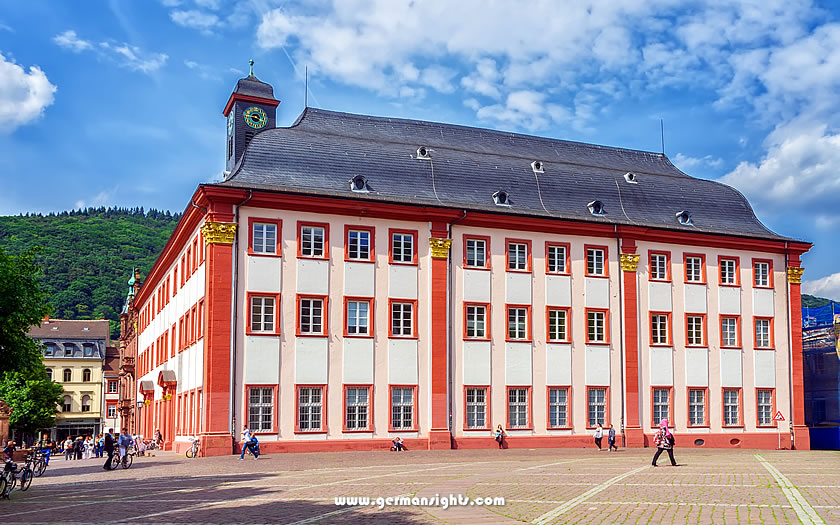
The Old University in Heidelberg
The University of Heidelberg was founded in 1386 as the first university in what is now Germany.
French troops destroyed the city in 1693 during the Palatinate War of Succession. It was then rebuilt in the Baroque style on its medieval layout.
During the 19th century, Heidelberg gained fame as a centre for poets and intellectuals, earning it the nickname "City of Romanticism".
The city grew into an academic hub and became a popular place to visit.
It remained largely undamaged during World War II. After the war, Heidelberg served as the headquarters for US Army forces in Europe until 2012.
Heidelberg has plenty going on throughout the year. Here are some of the highlights:
The Spring Festival is a series of musical festivals and concerts in the early part of the year. The series starts with a String Quartet Festival, usually in January, followed by a Classical Music Festival in March and April. A Choral Festival winds up the spring in June.
This is held three times a year: in June, July, and September. The event celebrates the city’s historic castle and the illumination is accompanied by a fireworks display.
This lively festival usually takes place in September or early October. The 'Wine Village' celebrates the history of viticulture in the area with stands and music throughout the old town.
This festival in the heart of the old town is held on the last weekend in September, with music and stalls in the streets and squares.
The Christmas market takes place during the Advent period. Heidelberg has 300 wooden stalls in various squares serving mulled wine and offering Christmas decorations.
More details here: Heidelberg Christmas Market
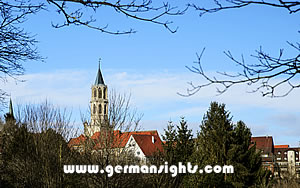
Rottweil is characterised by its medieval architecture and is renowned for being one of the oldest towns in the region. The city is noted for its centuries-old annual carnival tradition, Fasnet. It's also widely recognized for giving its name to the well-known breed, the Rottweiler dog.
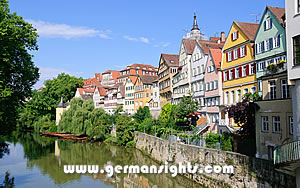
Tübingen dates back to the Middle Ages and is distinguished by its well-preserved old town featuring half-timbered houses and cobbled streets. Tübingen is also home to one of Europe's oldest universities, the Eberhard Karls University, established in 1477.
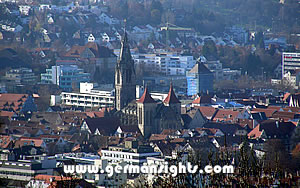
Reutlingen can boast several historical architectural sites from the Middle Ages, including its iconic town church, Marienkirche, and the imposing Tübinger Tor. It is located at the foot of the Swabian Jura and offers a blend of urban life and natural beauty.
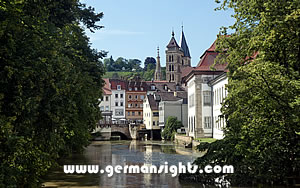
Esslingen is famous for its well-preserved medieval old town. The town is characterised by its half-timbered houses, majestic towers and the impressive Esslingen Castle. Once an influential imperial city in the Middle Ages, it is now known for its automotive and engineering industries.
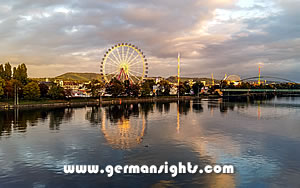
Stuttgart is a dynamic and diverse city in the heart of Baden-Württemberg. Founded in the 10th century, Stuttgart has transformed itself from a historic city into an automotive powerhouse, famously home to world-renowned car manufacturers such as Mercedes-Benz and Porsche.
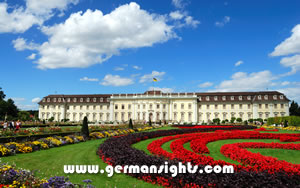
Founded in the early 18th century, Ludwigsburg is known for the Ludwigsburg Palace, one of the largest Baroque palaces in Germany surrounded by expansive, beautiful gardens. This city is also home to the Ludwigsburg Festival, a well-known international festival of music and performing arts.
Heidelberg has three tourist office locations.
One tourist information centre is at the main train station, Heidelberg Hauptbahnhof. This is open seven days a week in the summer months, with slightly shorter hours on Sundays and public holidays.
Another tourist information office is located in the city hall ('Rathaus') at Marktplatz in the city centre. This is open Monday to Saturday in the summer months, with slightly shorter hours on Saturdays.
A third tourist office is situated down by the river near the Alte Brücke on Neckarmünzplatz. This information centre is open seven days a week in the summer months, with slightly shorter opening hours on Sundays and public holidays.
In general, the opening hours of the locations in the winter months are more restricted.
Tourist Office: www.heidelberg.de